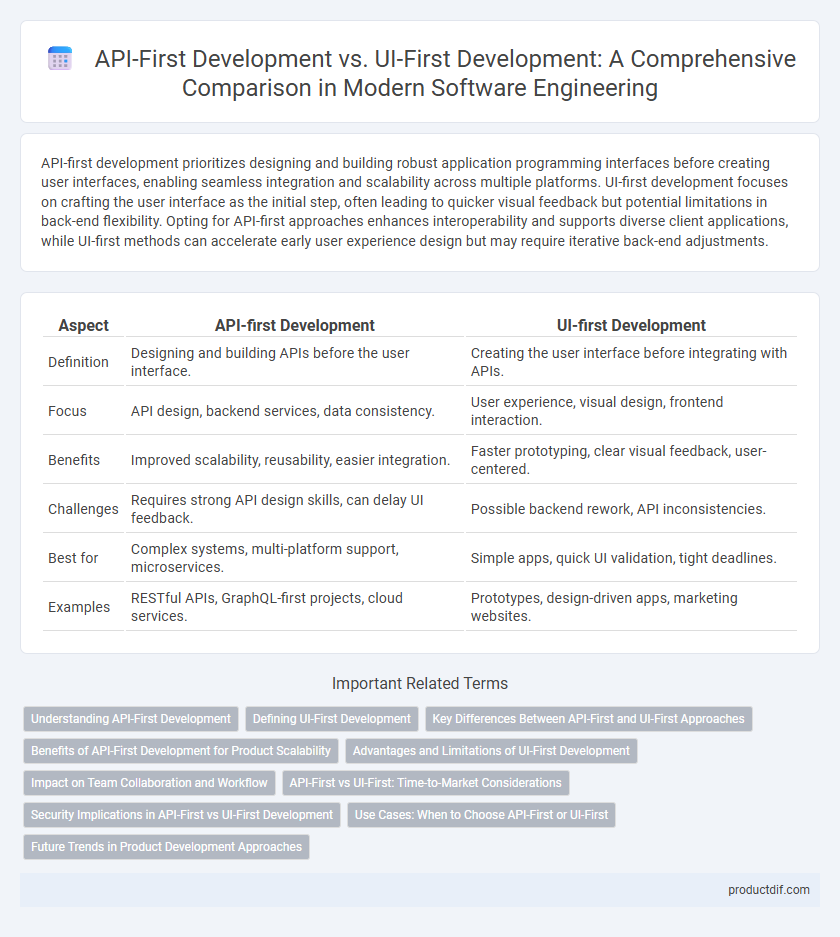API-first development prioritizes designing and building robust application programming interfaces before creating user interfaces, enabling seamless integration and scalability across multiple platforms. UI-first development focuses on crafting the user interface as the initial step, often leading to quicker visual feedback but potential limitations in back-end flexibility. Opting for API-first approaches enhances interoperability and supports diverse client applications, while UI-first methods can accelerate early user experience design but may require iterative back-end adjustments.
Table of Comparison
| Aspect | API-first Development | UI-first Development |
|---|---|---|
| Definition | Designing and building APIs before the user interface. | Creating the user interface before integrating with APIs. |
| Focus | API design, backend services, data consistency. | User experience, visual design, frontend interaction. |
| Benefits | Improved scalability, reusability, easier integration. | Faster prototyping, clear visual feedback, user-centered. |
| Challenges | Requires strong API design skills, can delay UI feedback. | Possible backend rework, API inconsistencies. |
| Best for | Complex systems, multi-platform support, microservices. | Simple apps, quick UI validation, tight deadlines. |
| Examples | RESTful APIs, GraphQL-first projects, cloud services. | Prototypes, design-driven apps, marketing websites. |
Understanding API-First Development
API-first development prioritizes designing and building APIs before the user interface, enabling seamless integrations and scalability across platforms. This approach ensures consistent data flow, promotes reusable services, and accelerates development cycles by decoupling front-end and back-end teams. Emphasizing API contracts early enhances collaboration and future-proofs applications in complex software ecosystems.
Defining UI-First Development
UI-First Development prioritizes designing the user interface before building the underlying application or APIs, emphasizing user experience and visual design as the foundation of the software. This approach ensures that the layout, interactions, and usability are perfected early, often using wireframes and prototypes to guide development. By focusing on UI-first, teams align functionality with user needs, but it may require later adjustments to APIs to accommodate the predefined interface.
Key Differences Between API-First and UI-First Approaches
API-first development prioritizes designing robust, scalable application programming interfaces before building the user interface, enabling seamless integration and improved backend flexibility. UI-first development focuses on crafting the user experience and interface design initially, often leading to tighter coupling between frontend and backend components but faster visual feedback. Key differences lie in workflow emphasis: API-first fosters modularity and reusability across multiple platforms, whereas UI-first accelerates initial design iterations with potential backend constraints.
Benefits of API-First Development for Product Scalability
API-first development enhances product scalability by enabling seamless integration across diverse platforms and services, facilitating modular architecture that supports independent component updates. This approach accelerates time-to-market through reusable APIs, promoting consistency and reducing redundancy across development teams. Emphasizing API design ensures robust backend functionality, enabling easier adaptation to evolving user demands and technology landscapes.
Advantages and Limitations of UI-First Development
UI-first development prioritizes designing the user interface before building the underlying API, enabling rapid prototyping and immediate user feedback for improved user experience. This approach streamlines front-end development but can lead to limitations such as poor scalability and inflexible integration with other systems, as APIs are often retrofitted rather than designed for broad functionality. UI-first development also risks tighter coupling between front-end and back-end, making future updates and maintenance more complex compared to API-first strategies.
Impact on Team Collaboration and Workflow
API-first development enhances team collaboration by enabling backend and frontend teams to work in parallel, reducing dependencies and streamlining workflows. This approach promotes clear communication through well-documented APIs, facilitating integration and continuous testing early in the development cycle. UI-first development often leads to sequential workflows where frontend design can delay backend implementation, impacting overall team synchronization and slowing down the development pace.
API-First vs UI-First: Time-to-Market Considerations
API-first development accelerates time-to-market by enabling parallel workflows, allowing backend and frontend teams to work simultaneously on well-defined interfaces. UI-first development often results in delays as frontend design dependencies may block backend progress and integration testing. Prioritizing API-first approaches improves scalability and accelerates iterative releases, crucial for competitive software delivery timelines.
Security Implications in API-First vs UI-First Development
API-first development prioritizes secure data exchange by enforcing strict access controls and authentication at the API layer, reducing vulnerabilities exposed through user interfaces. UI-first development often inherits security risks from client-side code, making it more susceptible to attacks like cross-site scripting (XSS) and injection flaws. Focusing on API-first design enhances security posture by centralizing security policies and minimizing attack surfaces across distributed applications.
Use Cases: When to Choose API-First or UI-First
API-first development excels in use cases requiring scalable integrations, multi-platform support, and backend-driven workflows, such as SaaS products and mobile applications. UI-first development is ideal for projects prioritizing rich user experiences and rapid prototyping, commonly seen in consumer-facing websites and interactive dashboards. Choosing between API-first and UI-first depends on whether the primary need is robust system interoperability or polished, intuitive user interfaces.
Future Trends in Product Development Approaches
API-first development emphasizes building robust, scalable backend services that facilitate seamless integration and interoperability across platforms, driving rapid innovation in cloud-native and microservices architectures. UI-first development prioritizes user experience and interface design, essential for consumer-facing applications where intuitive interaction remains critical. Future trends indicate a hybrid approach combining API-driven flexibility with adaptive UI frameworks, enabling agile product iterations and enhanced multi-channel delivery.
API-first Development vs UI-first Development Infographic

 productdif.com
productdif.com